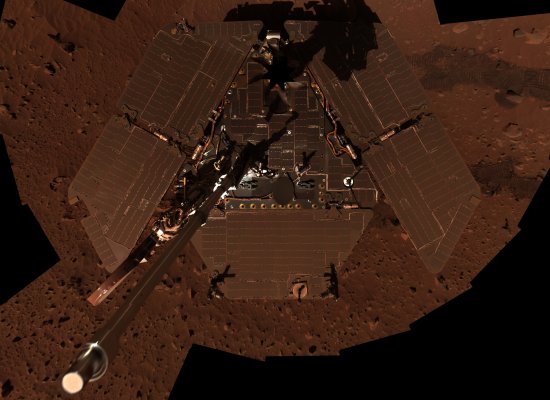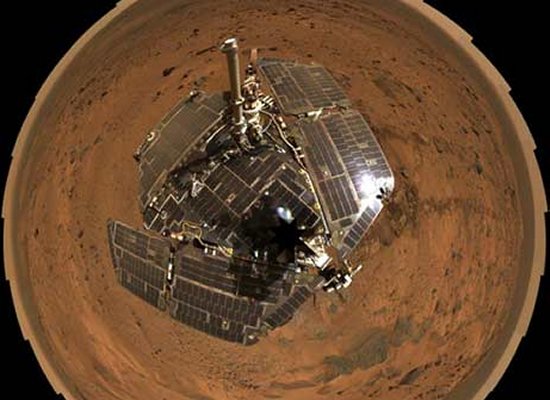|
||||||||||
|
|
||||||||||
|
||||||||||
|
|
||||||||||

The rover was still functioning well when the mission ended, but the battery used by the lander base station was only designed to recharge 40 times. After 40 Martian days, the battery could not maintain a full recharge making it unable to keep the lander warm during the bitterly cold nights. It is believed this factor probably resulted in a failure in the lander's electronics causing it to lose communication with Earth. Without the lander, the Sojourner rover was unable to continue operating on its own.
NASA's Jet Propulsion Laboratory built upon the remarkable success of Pathfinder by landing two much larger and more sophisticated rovers on Mars in 2004. The two craft, named Spirit and Opportunity, form the Mars Exploration Rover (MER) mission. Unlike the Pathfinder rover that required its lander for communications with Earth, Spirit and Opportunity are completely independent and communicate with ground controllers directly. Each rover has six wheels mounted to a suspension system called a "rocker-bogie" design. This concept is inherently stable and allows the rovers to travel over rough terrain, climb obstacles twice the diameter of the wheels, and survive inclination angles up to 45 degrees without tipping over. Each wheel has cleats and is driven by an individual motor for excellent traction. The front and rear wheels can also steer independently to make a complete 360° turn over the same position.

The rovers also feature a suite of instruments including a panoramic camera for detailed imagery of the terrain, a microscopic imager for close inspections of material, spectrometers to study the composition of rocks and soil, and an abrasion tool to expose the interior of rocks for study. Many of these tools are mounted on a robotic arm that can be extended from the rover and placed directly against objects of interest.
Spirit and Opportunity were built by the Jet Propulsion Laboratory and designed to last at least 90 days on the Martian surface. The rovers have proven quite robust and are still operating today, over 1,000 Martian days after landing. One of the reasons designers did not believe the rovers could last much beyond three months was the assumption that Martian dust would build up on each rover's solar panels that convert light from the Sun into electrical power. As dust collects on the panels, they become less efficient and produce less and less power to keep the rovers functional. NASA engineers believed this accumulation of dust would limit the rovers to no more than a few months of operation.

NASA's speculation on the dust accumulation rate over time was initially born out as Spirit's battery power dropped off during its mission. By early March 2005, for example, the rover's solar panel efficiency had decreased to 60%. The following day, however, efficiency suddenly jumped up to 93%. The reason for the rapid improvement was discovered to be dust devils that swept over the rover and blew the panels clear of debris. A similar situation occurred when the rover's power generation had plummeted to 40% but a strong wind cleaned the panels of dust and raised efficiency back to 93%. Several of these so-called "cleaning events" have been encountered by both rovers allowing them to produce far more power for much longer periods than originally anticipated.
Dust devils and winds continue to clean the rovers today and are one of the primary reasons the rovers have been able to last so much longer than planned. However, a number of other mechanical and electrical faults have taken their toll on the rovers. The motor used to stow Opportunity's robotic arm, for example, has shown a tendency to stall. The arm is now only stowed while the rover is traveling and is otherwise kept extended at night so that it will not get stuck in the cold temperatures.

Sprit suffered a flash memory problem shortly after landing that was eventually corrected by new software and a reformat of the memory system. Spirit's most troublesome failure, however, came on Martian day 779 when the right front wheel stopped working. The rover is now driven backward to drag the inoperable wheel while maintaining sufficient traction.
Despite these relatively minor problems, both Spirit and Opportunity are still functioning well and continue to generate valuable new information about Mars. The rovers celebrated their third anniversary in January 2007 and will likely remain operational for months or years to come. Unless stricken by a catastrophic and uncorrectable hardware failure, perhaps the most likely factor that could bring the mission to a close is funding. NASA has extended funding to continue the Mars Exploration Rover mission several times already, and the project is currently expected to last until at least September 2007. Given NASA's limited budget and commitments to other programs as well as political changes in Congress, however, finding resources to maintain the mission may become increasingly difficult.

Beyond Sojourner, Spirit, and Opportunity, two additional rover missions to Mars are also being prepared. NASA
is planning a considerably larger rover that will land on Mars in 2010. Called the Mars Science Laboratory (MSL),
this vehicle is twice as big and three times as heavy as the Mars Exploration Rovers and is designed to function
for at least one Martian year, or about two Earth years. Given its size and mission duration, MSL will be able to
travel much farther than previous rovers. MSL will also carry many more scientific instruments of greater
capability to search for water and any evidence that Mars once could or
currently can support life. Europe too is planning its own Martian lander and rover called ExoMars that will reach
the planet in 2014.
- answer by Jeff Scott, 18 March 2007
Update!
NASA has approved a new extension to the Mars Exploration Rover mission that continues funding for Spirit and
Opportunity for up to two more years. The original mission cost $820 million to design and construct the rovers,
launch them to Mars, and opporate the vehicles for 90 days. NASA also approved four previous extensions to
continue exploring the Martian surface, totaling $106 million. The latest extension is estimated to cost at least
$20 million and will fund the mission through the year 2009 assuming the rovers remain operational and productive.
- answer by Greg Alexander, 15 October 2007
Read More Articles:


|
Aircraft | Design | Ask Us | Shop | Search |

|
|
| About Us | Contact Us | Copyright © 1997- | |||
|
|
|||